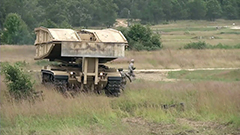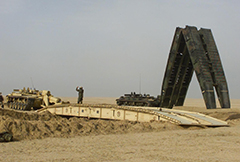Armoured Vehicle Launched Bridge (AVLB)
An armoured vehicle-launched bridge (AVLB) is a combat support vehicle, sometimes regarded as a subtype of military engineering vehicle, designed to assist militaries in rapidly deploying tanks and other armoured fighting vehicles across gap-type obstacles, such as rivers. The AVLB is usually a tracked vehicle converted from a tank chassis to carry a folding metal bridge instead of weapons. The AVLB's job is to allow armoured or infantry units to cross craters, anti-tank ditches, blown bridges, railroad cuts, canals, rivers and ravines), when a river too deep for vehicles to wade through is reached, and no bridge is conveniently located (or sufficiently sturdy, a substantial concern when moving 60-ton tanks).
 The bridge layer unfolds and launches its cargo, providing a ready-made bridge across the obstacle in only minutes. Once the span has been put in place, the AVLB vehicle detaches from the bridge, and moves aside to allow traffic to pass. Once all of the vehicles have crossed, it crosses the bridge itself and reattaches to the bridge on the other side. It then retracts the span ready to move off again. A similar procedure can be employed to allow crossings of small chasms or similar obstructions. AVLBs can carry bridges of 60 feet (19 metres) or greater in length. By using a tank chassis, the bridge layer is able to cover the same terrain as main battle tanks, and the provision of armour allows them to operate even in the face of enemy fire. However, this is not a universal attribute: some exceptionally sturdy 6x6 or 8x8 truck chassis have lent themselves to bridge-layer applications.
The bridge layer unfolds and launches its cargo, providing a ready-made bridge across the obstacle in only minutes. Once the span has been put in place, the AVLB vehicle detaches from the bridge, and moves aside to allow traffic to pass. Once all of the vehicles have crossed, it crosses the bridge itself and reattaches to the bridge on the other side. It then retracts the span ready to move off again. A similar procedure can be employed to allow crossings of small chasms or similar obstructions. AVLBs can carry bridges of 60 feet (19 metres) or greater in length. By using a tank chassis, the bridge layer is able to cover the same terrain as main battle tanks, and the provision of armour allows them to operate even in the face of enemy fire. However, this is not a universal attribute: some exceptionally sturdy 6x6 or 8x8 truck chassis have lent themselves to bridge-layer applications.
The roots of the modern AVLB can be found in World War I, at the dawn of tank warfare. Having developed tanks, the United Kingdom and France were confronted with the problem of mounting tank advances in the face of the trenches that dominated the battlefields. Early engagements, such as at Cambrai demonstrated the tank's utility, but also highlighted its vulnerability to battlefield geography—many early tanks found themselves ignominiously stuck in the trenches, having insufficiently long tracks to cross them. To counter this disadvantage, tanks (especially the common British Heavy tanks) began to go into battle with fascines hanging over their bows, sometimes as simple as a bundle of heavy sticks. By dropping these into the trenches, they were able to create a wedge over which the tank could drive. Later, some tanks began to carry rails on their decks—the first AVLBs.
By 1919, the British Army had, at its training centre in Christchurch, a Mark V** tank with lifting gear able to carry and place a bridge or carry out mine clearing and demolition. More details
 The bridge layer unfolds and launches its cargo, providing a ready-made bridge across the obstacle in only minutes. Once the span has been put in place, the AVLB vehicle detaches from the bridge, and moves aside to allow traffic to pass. Once all of the vehicles have crossed, it crosses the bridge itself and reattaches to the bridge on the other side. It then retracts the span ready to move off again. A similar procedure can be employed to allow crossings of small chasms or similar obstructions. AVLBs can carry bridges of 60 feet (19 metres) or greater in length. By using a tank chassis, the bridge layer is able to cover the same terrain as main battle tanks, and the provision of armour allows them to operate even in the face of enemy fire. However, this is not a universal attribute: some exceptionally sturdy 6x6 or 8x8 truck chassis have lent themselves to bridge-layer applications.
The bridge layer unfolds and launches its cargo, providing a ready-made bridge across the obstacle in only minutes. Once the span has been put in place, the AVLB vehicle detaches from the bridge, and moves aside to allow traffic to pass. Once all of the vehicles have crossed, it crosses the bridge itself and reattaches to the bridge on the other side. It then retracts the span ready to move off again. A similar procedure can be employed to allow crossings of small chasms or similar obstructions. AVLBs can carry bridges of 60 feet (19 metres) or greater in length. By using a tank chassis, the bridge layer is able to cover the same terrain as main battle tanks, and the provision of armour allows them to operate even in the face of enemy fire. However, this is not a universal attribute: some exceptionally sturdy 6x6 or 8x8 truck chassis have lent themselves to bridge-layer applications.The roots of the modern AVLB can be found in World War I, at the dawn of tank warfare. Having developed tanks, the United Kingdom and France were confronted with the problem of mounting tank advances in the face of the trenches that dominated the battlefields. Early engagements, such as at Cambrai demonstrated the tank's utility, but also highlighted its vulnerability to battlefield geography—many early tanks found themselves ignominiously stuck in the trenches, having insufficiently long tracks to cross them. To counter this disadvantage, tanks (especially the common British Heavy tanks) began to go into battle with fascines hanging over their bows, sometimes as simple as a bundle of heavy sticks. By dropping these into the trenches, they were able to create a wedge over which the tank could drive. Later, some tanks began to carry rails on their decks—the first AVLBs.
By 1919, the British Army had, at its training centre in Christchurch, a Mark V** tank with lifting gear able to carry and place a bridge or carry out mine clearing and demolition. More details

